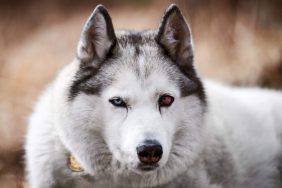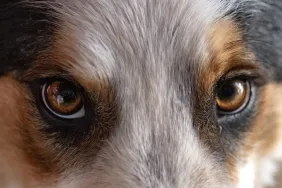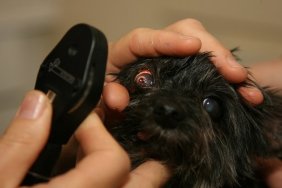Episcleritis in Canine: Signs, Causes, & Remedies
Episcleritis in canines is an inflammatory situation of the episclera, which is the skinny layer of tissue between the conjunctiva and sclera — the white a part of the attention. It’s characterised by localized or diffuse redness and swelling within the affected space, giving the attention an irritated or bloodshot look. Even so, episcleritis sometimes doesn’t threaten imaginative and prescient and is usually thought of a benign situation. Nonetheless, it could actually trigger discomfort for the canine and should generally be a recurring situation.
Right here’s what you need to know in regards to the signs, sorts, causes, and coverings for the situation in canines.
Signs of episcleritis in canines

Canine affected by episcleritis could exhibit quite a lot of signs, starting from gentle to extreme. The commonest signal is redness of the attention, notably across the space the place the white of the attention meets the coloured half. This redness is as a result of irritation and could also be accompanied by swelling. Different signs can embody:
- Extreme tearing or watery discharge from the attention
- Pawing or rubbing on the eyes
- Sensitivity to mild
- Seen blood vessels within the whites of the eyes
- Squinting or blinking regularly
- Raised nodules or bumps within the eye (within the case of nodular episcleritis)
- Discomfort or ache across the eyes
Varieties of episcleritis in canines
Episcleritis in canines will be categorised into two principal sorts primarily based on the looks and distribution of irritation. These are:
Diffuse episcleritis
Also called easy episcleritis, that is the extra frequent and fewer extreme type of the situation. It sometimes manifests as a localized, non-infectious irritation which will seem like a raised, pink space on the white a part of the attention. This kind can have an effect on one or each eyes and is usually self-limiting, that means it could actually resolve by itself with out intensive therapy. Canine with diffuse episcleritis usually keep regular imaginative and prescient and expertise few issues. Golden Retrievers and Cocker Spaniels are notably inclined to this type of episcleritis.
Nodular episcleritis
This kind of episcleritis is marked by the presence of well-defined and elevated nodules or lots on the episclera. These nodules — which might seem pink or pink — could also be mistaken for tumors however are literally inflammatory lesions. They will both be singular or a number of and normally have an effect on just one eye. Nodular episcleritis is typically known as nodular granulomatous episcleritis (NGE) as a result of granulomatous nature of the nodules. This way is mostly seen in Collies and will be recurrent.
Causes of episcleritis in canines

Whereas the precise reason behind episcleritis can generally be troublesome to pinpoint, there are a number of recognized elements and circumstances that may contribute to its improvement.
- Immune-mediated response: One of many major causes of episcleritis in canines is an immune-mediated response. This happens when the canine’s immune system mistakenly targets the tissues of the episclera, resulting in irritation. The explanations behind this immune misdirection will not be at all times clear, however it may be related to different systemic immune issues.
- Infections: Sure bacterial, viral, or fungal infections can result in episcleritis in canines. These infections could both straight invade the tissues of the attention or stimulate an immune response that leads to irritation.
- Allergic reactions: Some canines could develop episcleritis as a part of an allergic response. Allergens corresponding to pollen, mud, and even sure meals might probably set off an inflammatory response within the episclera.
- Trauma or damage: Bodily trauma to the attention or surrounding areas may trigger episcleritis. This could possibly be as a result of a direct damage — corresponding to a scratch or blow to the attention — which ends up in irritation as a part of the therapeutic course of.
- Underlying systemic illnesses: Episcleritis could generally be a secondary situation related to underlying systemic illnesses, corresponding to Lyme illness or systemic lupus erythematosus. These circumstances can predispose canines to episodes of eye irritation.
Remedies for episcleritis in canines
So as to deal with episcleritis, you’ll first must get an correct prognosis from a veterinarian to rule out different circumstances — like conjunctivitis or uveitis — which might current with related signs. Your vet will intently look at your canine’s eye with specialised devices to evaluate the extent of the irritation. They could additionally conduct further exams, corresponding to a Schirmer tear take a look at to measure tear manufacturing and a fluorescein stain to verify for corneal ulcers. In some instances, blood exams or a biopsy could also be essential to establish any underlying systemic points contributing to the irritation. As soon as a prognosis is confirmed, your veterinarian will talk about therapy choices with you to assist handle your canine’s situation successfully.
Therapy for episcleritis in canines sometimes includes the usage of anti-inflammatory drugs to scale back swelling and discomfort. Your vet would possibly prescribe topical corticosteroids or non-steroidal anti-inflammatory medication (NSAIDs). They may also present particular directions on the best way to apply these drugs and the way usually they need to be administered. You should definitely comply with these instructions intently to make sure your canine receives the complete advantage of the therapy. In case your canine’s episcleritis is related to an underlying systemic illness, treating that major situation may assist resolve the attention irritation.
Take into account that common follow-up visits to the vet are essential for monitoring your canine’s response to therapy and making any mandatory changes. You’ll additionally wish to observe your canine’s signs at dwelling and get in touch with your vet straight away when you discover any uncommon modifications. Furthermore, preserving your canine’s surroundings freed from irritants and sustaining good eye hygiene can assist the therapeutic course of and assist stop recurrences.
What’s the distinction between episcleritis and scleritis?
It’s price noting that episcleritis is usually confused with scleritis, however there are key variations between the 2 circumstances. Scleritis includes a deeper and extra extreme irritation affecting the sclera itself, whereas episcleritis is proscribed to the outer layer. Moreover, scleritis tends to be extra painful and may result in severe issues, together with imaginative and prescient loss, if not handled promptly. Episcleritis, however, is usually milder and fewer prone to trigger long-term harm.
Associated articles on canine well being

Scleritis in canines is an inflammatory situation affecting the sclera — the white outer layer of the eyeball. The sclera…

Collie eye anomaly in canines is an inherited, congenital situation, that means canines have it from start. It happens due to a…

Allergic reactions in canines will be troublesome to identify, as they range in sort, severity, and trigger. Virtually any substance…

Pink eye in canines, also referred to as “pink eye” or conjunctivitis, is an itchy irritation of the tissue within the…

Eye defects in canines will be attributable to congenital elements. Normally, congenital eye defects will be seen quickly after a…

